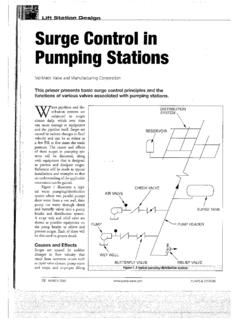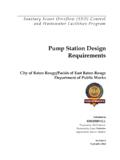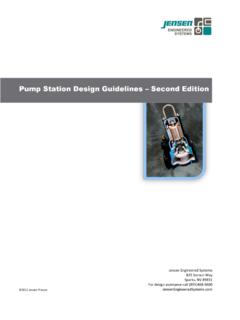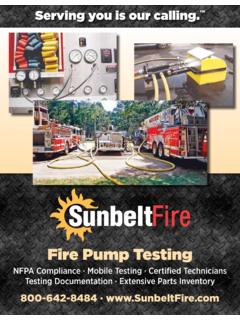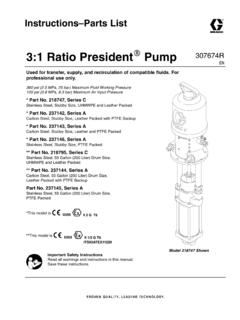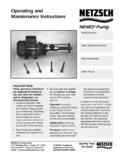Transcription of CHAPTER 10 PUMP STATIONS - michigan.gov
1 CHAPTER 10 PUMP STATIONS NOTE: All questions and comments should be directed to the Drainage Specialist, Design Support Area. Revised January 2006 Pump STATIONS 10-2 MDOT Drainage Manual CHAPTER Table of Contents Introduction 10-4 Definitions 10-6 General Design Criteria 10-8 Hydrology and Storage 10-8 Station Design 10-10 Design Considerations
2 10-10 Station Type and Depth 10-11 Wet Well Design 10-15 Collection Systems 10-19 Structure 10-19 Trashracks 10-20 Roof Hatches 10-21 Equipment Certification and Testing 10-21 Monitoring 10-21 Safety 10-21 Outlet Design/Discharge System 10-22 Mechanical System 10-23 Pump Types 10-23 Vertical pumps 10-23 Radial Flow pumps 10-24 Pump Selection 10-25 Pump Number and Capacity 10-25 Final Pump Selection 10-26 Electrical System 10-27 Requirements
3 10-27 Code Compliance 10-28 Operation 10-28 Power Supply and Service Connections 10-28 Materials 10-28 Service Cables 10-28 Wire and Cable 10-28 Conduit and Fittings 10-29 Light Fixtures 10-29 Switches 10-29 Pump STATIONS 10-3 MDOT Drainage Manual Receptacles 10-29 Motor Control Center 10-30 Automatic Sequence Selector Switch 10-30 Miscellaneous 10-31 Lighting Transformer 10-31 Lighting Distribution Panel 10-31 Transformer Disconnect 10-31 Main Power Disconnect 10-31
4 Installation and Wiring 10-31 Grounding 10-32 Retrofitting 10-33 Maintenance 10-34 References 10-35 Web links 10-36 Appendices 10-A Symbols and Acronyms 10-A-1 10-B Pump Station Hydraulic Design Example 10-B-1 Figures 10-1 Estimating Required Storage 10-9 10-2 Sample Submersible Pump Layout 10-12 10-3 Sample Vertical Pump Layout 10-13 10-4 Sample Dry Pit Station Layout 10-14 10-5 pumps with Cyclical Running Alternation 10-17 Pump STATIONS 10-4 MDOT Drainage Manual INTRODUCTION This CHAPTER describes the major components and design considerations for stormwater pump STATIONS and makes recommendations on some characteristics to achieve the most cost-effective design and installation.
5 The Project Manager should coordinate project-related work with the Design Engineer-Municipal Utilities Unit, Design Engineer - Electrical Unit, and the Design Engineer - Hydraulics/Hydrology Unit. The information in this CHAPTER is a guideline to the design, operation, construction, and maintenance of MDOT pump STATIONS and their structural, mechanical, and electrical systems. The information in this CHAPTER has been divided into five categories: General Design, Section Mechanical System, Section Electrical System, Section Retrofitting, Section Maintenance, Section Stormwater pump STATIONS are necessary to remove stormwater from highway sections that cannot be drained by gravity.
6 Because of high costs and the potential problems associated with pump STATIONS , their use is recommended only where other systems are not feasible. When operation and maintenance costs are capitalized, a considerable expenditure can be justified for a gravity system. Alternatives to pump STATIONS include deep tunnels, siphons, and infiltration systems, although infiltration systems are often aesthetically displeasing and can create maintenance problems. This CHAPTER complements information and general guidance found in FHWA's, HEC-24, Manual for Highway Storm Water Pumping STATIONS , although typical pump station design procedure presented in the current FHWA Manual differs from MDOT s trunkline stormwater pump station design, construction, and maintenance practices.
7 Pump station design presents the designer with a challenge to provide a cost-effective drainage system that meets the needs of the project. There are many considerations involved in their design. Below is a listing of some of them. Wet pit vs. dry pit (Section ) Type of pumps (Section ) Number and capacity of pumps (Section ) Peak flow vs. storage (Section ) Force main vs. gravity (Section ) Above vs. below grade (Section ) Monitoring systems (Section ) Backup power systems (Section ) Maintenance requirements (Section ) Pump STATIONS 10-5 MDOT Drainage Manual Flow control using variable speed pumps or throttling valves (may not be practical due to high cost) Risk management and life cycle cost analysis (Section ) Retrofitting existing pump STATIONS (Section ) Many of the decisions regarding these factors are currently based on engineering judgment and experience.
8 To assure cost-effectiveness, the designer should assess each choice and develop economic comparisons of alternatives on the basis of annual cost. However, some general recommendations, as discussed in this CHAPTER , can be made which will help minimize the design effort and the cost of these expensive drainage facilities. For further information on the design and use of pump STATIONS see, Highway Storm Water Pumping STATIONS , Volumes 1 and 2, FHWA-IP-82-17, NTIS Numbers PB 84-152727 and 152735, and the other references given at the end of this CHAPTER .
9 The Hydraulic Institute, 9 Sylvan Way, Parsippany, New Jersey 07054-3802, has developed standards for pumps . Pump station design should be consistent with these standards. For mechanical, electrical, and miscellaneous metal work (including field coating) refer to MDOT s Standard Specifications for Construction. Pump STATIONS 10-6 MDOT Drainage Manual DEFINITIONS Following are discussions of concepts which will be important in the design of pump STATIONS . These concepts will be used throughout this CHAPTER . Air/Vacuum Valve - An Air/Vacuum valve is used to allow air to escape the discharge piping when pumping begins, and to prevent vacuum damage to the discharge piping when pumping stops.
10 If the pump discharge is open to the atmosphere, an air/vacuum release valve may not be necessary. Combination air release valves are frequently used at high points in force mains to evacuate trapped air. Anti Ratchet Device - A device used to stop backflow from reversing the direction of pump and motor rotation in vertical shaft pumps . Installation of this type of device is mandatory in all vertical shaft pump equipped STATIONS . Check Valve - A watertight fitting used in pipes to prevent back flow to the pumps and subsequent re-circulation.










